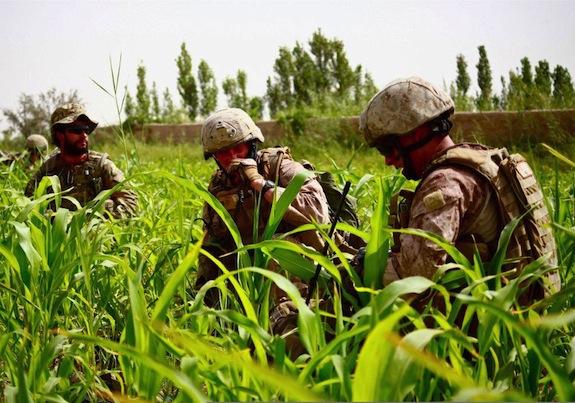The Internet on the Battlefield Could Be Way Better
On the battlefield, having internet to communicate with one another, control objects and weapons, and calculate positions can be extremely important

Image: DARPA
Most of us spend our time on the internet looking at cat videos and long lists of animals in different types of sweaters. But some people, like soldiers, actually use the internet for critical work—communicating with one another, controlling objects and weapons and calculating positions. As important as the internet has become to soldiers, they’re not exactly in locations where setting up an internet connection is easy, and DARPA is looking for ways to make the battlefield internet better.
Normally, soldiers use something like Mobile ad hoc networks (MANET), a way to build a network without cable lines or infrastructure. Made up of a set of nodes, the MANET structure simply sends information between individuals, rather than going through a main router like your internet does. But the number of nodes that MANET can deal with tops off at about 50, and there are often more than 50 soldiers moving about at a time.
Citing 20 years of failure in adapting internet-based ideas task, DARPA is soliciting research paper abstracts that look elsewhere, and they’re dreaming big. A small, 50 node network is useful, but with more nodes a much larger force could benefit from increased battlefield awareness on a tremendous scale, and could do so as events unfold, rather than waiting for information sent up to headquarters to be sent back down again.
In its call for research help, DARPA frames the problem this way:
Are large scale Mobile Ad-hoc Networks (MANET) possible? If so, what problems does the industry have to solve and what software needs to be developed? DARPA’s goal is to field MANETs with 1000- 5000 nodes. But it is difficult to field a MANET with 50 nodes. Why is this? DARPA plans to host a symposium to explore this question.
What they don’t want, they say, is a tweaked version of what they already have. “It is not about redesigning or rearchitecting the Internet; there are other ongoing efforts focused here. It is not about developing protocols for use in commercial applications or in areas with well supported, ubiquitous infrastructure,” the report explains.
Now, the idea of a battlefield internet isn’t new, of course. And some argue that thinking of each soldier as a node in a network is misguided. David Axe at the Center for Public Integrity writes:
By transforming every soldier into a communications node, capable of transmitting and receiving large volumes of data from many sources, Army leaders imagined they could chart the path to an era of high-tech wars in which information was as important as bullets and shells.
But in doing so, the planners went the wrong way, according to independent analysts. Instead of repairing their communications problems with lighter, easier-to-use radios, and a simpler network, they chose heavier, more complex devices.
But DARPA says that the real issue is increasing the number of nodes. If each soldier can become a node, the issue of complexity of battle becomes less of an issue. Mark Rich, a program manager at DARPA, said, “A MANET of a thousand nodes could support an entire battalion without the need for manual network setup, management and maintenance that comes from ‘switchboard’-era communications. This could provide more troops with robust services such as real-time video imagery, enhanced situational awareness and other services that we have not yet imagined.”
More from Smithsonian.com:
New Camouflage Makeup Protects Soldiers From Bomb Burns
For Soldiers, Sperm Banking Could Be the New Flack Jacket
/https://tf-cmsv2-smithsonianmag-media.s3.amazonaws.com/accounts/headshot/Rose-Eveleth-240.jpg)
/https://tf-cmsv2-smithsonianmag-media.s3.amazonaws.com/accounts/headshot/Rose-Eveleth-240.jpg)